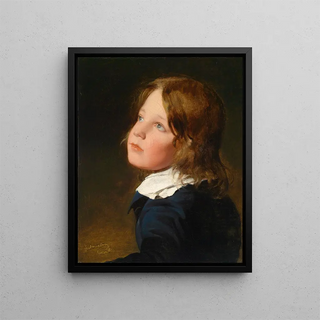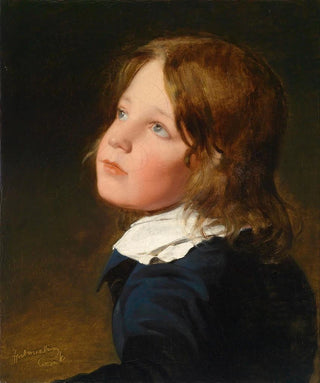Art print | Joseph Amerling enfant - Friedrich von Amerling


View from behind

Frame (optional)
Joseph Amerling Child - Friedrich von Amerling – Captivating Introduction
In the fascinating world of art, some works manage to transcend their era and capture the essence of innocence and youthful beauty. "Joseph Amerling Child" by Friedrich von Amerling is one of these iconic pieces. This artwork, created in the 19th century, immerses us in a world where a child's gaze becomes the mirror of the soul. The finesse of the details, the brilliance of the colors, and the delicacy of the child's features captured on the canvas invite us to explore a moment suspended in time. This painting is not merely a simple representation; it evokes deep emotions and a bittersweet nostalgia, reminding us all of the purity of our own childhood.
Style and uniqueness of the work
Friedrich von Amerling's style is distinguished by his ability to blend realism and romanticism, creating a unique atmosphere imbued with gentleness. In "Joseph Amerling Child," the artist employs a palette of delicate colors that enhance the brightness of the child's face. The nuances of flesh tones, the reflections in the eyes, and the texture of the hair are rendered with such precision that they seem almost tangible. Amerling excels in portrait art but also manages to infuse an emotional dimension into his subjects. The child's gaze, both curious and dreamy, engages us and prompts reflection on the fragility of childhood and the ephemeral beauty of passing time. The composition, balanced and harmonious, reinforces this sense of intimacy, making this work a true masterpiece.
The artist and his influence
Friedrich von Amerling, born in 1803 in Vienna, was an Austrian painter whose work marked the 19th century. Trained at the Vienna Academy of Fine Arts, he was influenced by the masters of the past while developing a style that was uniquely his own. Amerling established himself as a preferred portraitist, attracting the attention of the aristocracy and bourgeoisie of his time. His innovative approach to portraiture, which combines realism and sensitivity, paved the way for many artists who

Matte finish

View from behind

Frame (optional)
Joseph Amerling Child - Friedrich von Amerling – Captivating Introduction
In the fascinating world of art, some works manage to transcend their era and capture the essence of innocence and youthful beauty. "Joseph Amerling Child" by Friedrich von Amerling is one of these iconic pieces. This artwork, created in the 19th century, immerses us in a world where a child's gaze becomes the mirror of the soul. The finesse of the details, the brilliance of the colors, and the delicacy of the child's features captured on the canvas invite us to explore a moment suspended in time. This painting is not merely a simple representation; it evokes deep emotions and a bittersweet nostalgia, reminding us all of the purity of our own childhood.
Style and uniqueness of the work
Friedrich von Amerling's style is distinguished by his ability to blend realism and romanticism, creating a unique atmosphere imbued with gentleness. In "Joseph Amerling Child," the artist employs a palette of delicate colors that enhance the brightness of the child's face. The nuances of flesh tones, the reflections in the eyes, and the texture of the hair are rendered with such precision that they seem almost tangible. Amerling excels in portrait art but also manages to infuse an emotional dimension into his subjects. The child's gaze, both curious and dreamy, engages us and prompts reflection on the fragility of childhood and the ephemeral beauty of passing time. The composition, balanced and harmonious, reinforces this sense of intimacy, making this work a true masterpiece.
The artist and his influence
Friedrich von Amerling, born in 1803 in Vienna, was an Austrian painter whose work marked the 19th century. Trained at the Vienna Academy of Fine Arts, he was influenced by the masters of the past while developing a style that was uniquely his own. Amerling established himself as a preferred portraitist, attracting the attention of the aristocracy and bourgeoisie of his time. His innovative approach to portraiture, which combines realism and sensitivity, paved the way for many artists who






